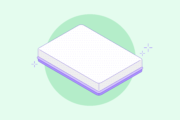
Mattress Buying Guide

- The lifespan of a mattress is typically 7 to 10 years, but it’s crucial to prioritize your comfort. If you consistently wake up uncomfortable, regardless of the mattress’s age, it’s time for a change.
- There are various mattress types, such as innerspring, memory foam, and hybrid. The best mattress type is subjective and depends on personal comfort preferences. Whether it’s the bounciness of innerspring or the contouring of memory foam, choose what feels right for you.
- Mattresses come in different firmness levels, and there’s no universal standard. Consider factors like your sleeping position, chronic pain, body weight, and whether you share the bed.
Buying a new mattress can be seriously rewarding. (More restful sleep! Fewer aches and pains in the morning!) But all that research can sometimes feel like a lot of work. So what can you do to make it easier?
Most beds have a lifespan of 7 to 10 years. But really, you’re better off going by how you feel. Whether you’ve had your bed for one year or more than a decade, if you’re consistently waking up uncomfortable, it’s time to hit the (brick and mortar or online) store and ditch your old bed.
If the shopping process has you overwhelmed, you’ve come to the right place. This basic mattress buying guide can help you narrow down your options and find a bed that’ll deliver a good night’s sleep for years to come.
Mattress types—which is the best?
There are about eight zillion mattresses out there, but only a few actual types of mattresses.
One mattress type isn’t necessarily better than the other. It’s about what feels most comfortable to you. Some shoppers are happy to stick with innerspring beds. But if your spring mattress hasn’t delivered on comfort the way you hoped, it might be worth giving a hybrid mattress or memory foam bed a try.
The first part of finding the best mattress is all about narrowing down your options to a few potential contenders. That starts with deciding on whether you plan to get a traditional innerspring bed or a memory foam mattress.
Innerspring mattresses
The most common mattress type, innerspring mattresses utilize support cores made of small metal coils. The coils are topped with layers of compressed foam and fluffy fibers for added comfort and cushioning.
All those springs make these beds feel bouncy and, well, springy. That can feel nice at first, but be warned. Over time, innerspring coils can start to wear down, leading to sagging and lumps that diminish the overall lifespan of your bed.
Memory foam mattresses
Though less common, this type of mattress has been steadily growing in popularity. Memory foam is made from a special type of polyurethane called viscoelastic foam, which has a responsive, open-cell structure designed to conform and mold to the body. Most foams are petroleum-based, but some brands reduce the petroleum content by infusing their foam with gel beads or plant-based oils.
The material’s responsiveness means that memory foam contours to the body’s natural curves, which can offer significant pressure relief. Some sleepers describe the feeling as more melting or floating than bouncing. Overall, memory foam mattresses get high ratings for their overall comfort and ability to reduce pressure points. But if you’ve been used to sleeping on a spring mattress, they can take some getting used to.
See our memory foam mattress buying guide for an in-depth examination of the type.
Hybrid mattresses
Hybrid mattresses offer dual support systems in the form of innerspring and memory foam. They tend to have a bouncier feel than classic foam beds but offer more support than traditional innerspring mattresses.
Mattress firmness levels—what’s most comfortable?
Mattresses come in soft, medium, or firm—and even some grades in between. So how can you know which one will give you the best night’s sleep? First, know that there aren’t any standards for these terms. One manufacturer’s “firm” could be another manufacturer’s “soft,” for instance.
Trying beds in person or reading reviews can give you an idea of the firmness level that feels best for you. Manufacturer’s websites might have helpful info on the types of consumers that do best with different firmness levels.
Medium-firm mattresses tend to be a good place to start—they’re a middle-of-the-road option with broad appeal. But in order to figure out your optimum firmness, you’ll also want to consider things like:
- Your sleeping position. We recommend medium mattresses for side sleepers and firm mattresses for stomach sleepers. Back sleepers can be comfortable with a soft, medium, or firm bed, unless you also happen to deal with chronic back pain.
- Whether you deal with chronic pain. The best mattresses for back pain relief are usually medium or medium-firm. These beds are also great at alleviating neck and hip pain, too.
- Your size and body weight. The more you weigh, the more force you exert on your bed. Slim folks may find a softer mattress to be the most supportive, while those who are heavier might like a firmer mattress better.
- Whether you share the bed with a partner. If you and your partner have different ideas on what counts as comfortable, a medium-firm mattress could be a good compromise.
Decide on your budget
A new mattress is a long-term investment in your sleep—and by extension, in your health. It’s certainly worth buying a high-quality mattress over a bargain bed, but that doesn’t mean you need to spring for the priciest option out there. Here’s an idea of what you’ll get for different price points.
- $750 to $1,000: Think of this as the entry-level price range for innerspring or memory foam mattresses. You’ll be able to get a budget mattress that’s comfortable, but it probably won’t come with any extra bells and whistles.
- $1,000 to $3,000: Mattresses in this price range tend to be both higher quality and more durable than those under $1,000. They might also come with extras like comfort layer pillow tops, motion isolation, or edge support.
- Over $3,000: You certainly don’t have to spend this much to find one of the most comfortable mattresses that will last for years. Top-of-the-line options offer luxe extras like more coils, thicker foam layers, or extra-plush materials, which can be nice to have, but they’re not necessary to sleep soundly.
Finally, keep in mind that mattress size matters. The bigger the bed, the more you’ll pay, with king and California king size mattresses being the most expensive.
Consider online mattress brands
You have a ballpark idea about the type of bed you might like and how much you’re willing to spend. So should you hit a traditional showroom or go shopping online? At showrooms, you’ll find legacy mattress companies. Dealing with household names can be reassuring, plus, it can be nice to be able to feel a mattress in person before you buy it.
But buying a mattress online has more perks than you might think. Online retailers like Amerisleep, Purple, and Tuft & Needle focus on their websites and sell direct to shoppers. Instead of relying on salespeople, they cut out the middleman and put consumers in charge of gathering information and making their best buying decision.

But if you buy a bed online, how can you tell whether it’ll actually be comfortable? You might assume that brands sold in stores have fewer returns and happier customers, but that’s not the case. Turns out, online mattress shoppers are more likely to report being satisfied with their new bed.
Going from store to store might seem like it’ll give you more options. But legacy brands often make it hard to compare products from one showroom to the next. Many provide major mattress stores with “unique” or “exclusive” lines that exist simply to make price matching and comparison shopping more difficult. That could mean you end up paying more for a product that doesn’t actually deliver better value.
It’s a whole different ballgame online. Online-based manufacturers typically only sell their beds through their websites. That makes it easy to compare different mattress models and find the option that’s best for you—and your budget. In fact, the ease of comparing is why so many shoppers love the online bed buying experience. When you feel like you know exactly what you’re buying, you walk away with a better sense of value.
There’s more. Most online mattress brands offer free delivery, a generous at-home trial period, plus no-hassle returns. That’s a lot better than trying a mattress for 10 minutes at the store while a salesperson hovers over you, right?
Start reading reviews
Have a few beds in mind that seem like they could be your perfect mattress? Looking through customer reviews can help you pinpoint the option you’ll be happiest with—whether you’re shopping online or heading to a traditional showroom.
Online reviews can give you a good idea of what customers really think of a bed after they’ve had some time to try it out at home. They can also help you learn important things about a brand. For instance, how easy was the buying and delivery process? If the customer needed to make a return, was that a hassle? Great customer service might be the tiebreaker between two mattress options, so it’s worth knowing about.
The key to using customer feedback to your advantage, of course, is finding comments that are real and unbiased. The best brands use a third-party certifier like PowerReviews to verify their reviews. Having a certifier like this means that the brand can’t control or edit the feedback it gets. So if a customer writes something unflattering, there’s no changing it. It’s there for everyone to see.
Without a verification feature, there’s no way to know for sure if a brand’s reviews are authentic. They could be real—but they could also be manipulated or totally fabricated. And that could make it harder for you to successfully compare options and find the best mattress for you.
Check the fine print
Sure, you’re probably spending the bulk of your time comparing mattress features. But it’s worth paying attention to details like a brand’s warranty and return policy. Those kinds of things could make or break your return experience if the bed turns out to be a bad fit or has some kind of defect.
The first thing to consider: Does the brand offer an at-home trial or generous return period where you can return the bed if you decide you don’t like it? This is absolutely worth having, since it can take several nights or weeks to adjust to a new mattress and decide if it’s really right for you. The brand or retailer should offer at least 30 days to return the bed, no questions asked. But many higher-quality brands offer windows of up to 90 days.
Speaking of returns, how difficult are they? Will you have to pay a restocking fee or is the return free of charge? Will you be the one who has to pack and ship the bed, or will the manufacturer come to your house to pick it up? Will you be able to get a full refund or will you have to exchange the bed for another model made by the same manufacturer? Checking on all these details ahead of time could potentially save you a big headache down the road.
Get information, too, on the warranty. These cover any problems with the mattress that wasn’t your fault—usually things related to durability or manufacturing. Ideally, you should seek out a 10-year warranty for full coverage, with an additional prorated period where the manufacturer will cover a portion of the costs depending on how old the mattress is.

Time your mattress purchase
Sometimes things happen and you need a new mattress ASAP. But if you’re able to wait a little while, you might end up reaping big savings. Most mattress manufacturers and retailers run sales on predictable holiday weekends—think President’s Day, Memorial Day, the Fourth of July, Labor Day, and Black Friday.
We have guides on the various mattress sales with recommendations and shopping tips:
- Best MLK Day Mattress Sales
- Best Presidents Day Mattress Sales
- Best Sleep Awareness Week Mattress Sales
- Best Memorial Day Mattress Sales
- Best 4th of July Mattress Sales
- Best Labor Day Mattress Sales
- Best Columbus Day Mattress Sales
- Best Black Friday Mattress Sales
- Best Cyber Monday Mattress Sales
Timing your buy with a discount event could help you save several hundred dollars, and even bring a more expensive mattress into your price range.
Give it a good try
Even if you prefer the experience of shopping at a traditional showroom, you’ll probably agree that laying on a mattress for five or 10 minutes at the store isn’t enough to help you figure out whether you’ll it’s the right bed for you. It takes several nights—or even several weeks—to really test out a mattress and figure out whether it’s right for you.
So once your bed is delivered, it’s time to give it a solid test run. The biggest question you’ll be asking yourself, of course, is whether your sleeping experience is more comfortable. Noticing less stiffness or pain in the morning is a good sign. Another is waking up more refreshed in the morning and having more energy throughout the day, since you’re tossing and turning less at night.
A few other questions to consider:
- Are you waking up hot in the middle of the night? If so, your mattress might not be breathable enough for you.
- Does the mattress have a chemical smell? That could be off-gassing, which is a common occurrence for new mattresses and furniture. It should dissipate within a few weeks, but you can contact the manufacturer if it doesn’t seem to be going away.
- If you share the bed, are you waking up when your partner moves or gets up? If so, your mattress might have too much motion transfer for you.
Frequently Asked Questions
Is a firm mattress good for side sleepers?
A firm mattress is usually not the best choice for a side sleeper, although it can be a good choice for a back or stomach sleeper. When a side sleeper sleeps on a firm mattress, pressure points tend to build up in their hips and shoulders. A firm mattress can also raise a side sleeper’s spine out of alignment, causing back pain.
Which mattress is best for back pain?
A mattress with a medium-firm feel can ease back pain, according to science. When it comes to reducing pain and relieving pressure, memory foam and latex are excellent choices. You can consider an all-foam mattress or a hybrid with a foam layer.
Where do people buy mattresses?
The Internet is becoming an increasingly common way to buy a mattress, thanks to the idea behind mattresses in a box. You can choose a mattress and have it shipped straight to your front door, and the bed often includes a sleep trial that lets you try it out within the comfort of your home. Plus, online sellers usually offer lower prices on their mattresses than a traditional storefront would.
That’s not to say that people aren’t still buying mattresses from a local showroom or furniture store. Many customers still like to try out a mattress model in a showroom before buying it.
Can you negotiate the price of a mattress?
If you go to your local mattress store to shop, you might be able to haggle down the price or convince the store to price match a deal elsewhere. This isn’t the money saver you might think it is, however, since mattress stores mark up their prices by a wide percentage. Online retailers don’t offer an opportunity to negotiate but their prices start and stay low.
How much should I spend on a mattress?
This largely comes down to how you intend to use the mattress and what materials and features you want. If you’re looking for an occasional use mattress for a guest room, you probably don’t need to pay as much as you would for luxury mattress you want to sleep on every night. Organic materials such as a latex mattress with a cotton cover usually cost more than a memory foam mattress with a polyester cover.
You can find quality queen size mattresses for $1000 to $2500, and even a few hidden gems of mattresses for under $1000.
The bottom line on buying a new mattress
Mattress shopping takes a little bit of looking around to find comfortable options that will meet your needs and fit in your price range. So do your homework, be diligent, and don’t be afraid to shop around. The ultimate results—a good mattress that delivers better sleep and more energy—are well worth it.



